Abstract
A laser powder bed fusion (LPBF) Inconel 718 (IN718) alloy was fabricated under different process parameters, and the samples with optimal process parameters were treated by subsequent heat treatment. The outcomes demonstrated that the pores’ size and shape were influenced by the process parameters. The porosity of the samples first grew and subsequently reduced as the volume energy density increased, and the types of pores changed from lack-of-fusion pores to gas holes and keyhole pores. The porosity of the samples with three process parameters were 3.46%, 0.15% and 1.26%, respectively. The sample of 60.0 J/mm3 was chosen for a single solution (heat treatment at 980 °C for 1 h, SS) and direct aging (heat treatment at 720 °C for 8 h and then 620 °C for 8 h, DA), and the microstructure evolution of the samples was examined. Because of the segregation of the elements Nb and Mo, the Laves phase was distributed among the dendrites in the as-built (AB) sample. The solution heat treatment dissolved the Laves phase and precipitated the δ phase, while aging heat treatment precipitated the γ′/γ” phases. Additionally, the impact of the second phase on the tensile characteristics was looked into. The DA sample had the highest strength, with a tensile strength of 1458 MPa and a yield strength of 1271 MPa. With tensile and yield strengths of 980 MPa and 620 MPa, respectively, the AB sample had the lowest strength due to the Laves phase’s role as the crack initiator. The Laves phase dissolved and the γ′/γ”-strengthened phase precipitated, leading to an increase in the strength of the heat-treated specimens.
1. Introduction
The laser rapid prototyping of metal powders is an effective way to manufacture complex parts, and the most promising method is laser powder bed fusion (LPBF) [1,2]. The integrated structural and functional manufacturing of complex components for gas turbines and aero engines is made possible by LPBF, a cutting-edge free digital-material-processing technique [3,4]. The precipitation-strengthened nickel-base superalloy Inconel 718 (IN718) is an ideal material for LPBF because of its high weldability and excellent elevated-temperature mechanical properties [5,6,7]. The nuclear, chemical, petroleum and aerospace industries all use IN718 alloy extensively. The traditional manufacturing process, however, is laborious and time-consuming, and it is unable to produce aerospace parts with the high level of precision required for the IN718 parts’ complex structural design. LPBF is a key candidate in the manufacturing of complex IN718 alloy parts because it provides a time- and money-efficient method for creating parts with complex geometries. IN718 alloy is strengthened by the principal phase γ″ (Ni3Nb) and the auxiliary phase γ′ (Ni3(Al,Ti)), and the microstructure also contains the Laves phase (Ni,Fe,Cr)2(Nb,Mo,Ti) and the δ phase (Ni3Nb) [8]. Therefore, an investigation of the process parameters is important to understanding the formation of different phases, optimization of the surface quality and control of the microstructure.
The difference in porosity is the primary indicator of how the LPBF IN718 alloy is affected by process parameters. Process parameters’ effects on porosity defects and mechanical characteristics have been the subject of extensive research [9,10,11]. Watring et al. [12] compared three different build conditions leading to the worst and best fatigue life. It was discovered that, when compared to specimens with high laser energy densities, the low laser energy density specimens’ high proportion of unfused pores significantly reduced their mechanical properties. They proposed that the structure–property relationship of the built Inconel 718 could be tuned by optimizing laser energy density and build orientation. Yang et al. [13] studied the effect of laser power on the formability, microstructure evolution and tensile properties of the LPBF IN718 alloy. When the laser power increased, it was discovered that the process window for fully dense molding shrunk. Leon Nope et al. [14] performed a factorial design to investigate the individual effects and interactions of process parameters on melt pool depth, porosity, mesostructured defects and microstructure. They showed that process exposure parameters need to be optimized to ensure that parts fabricated by LPBF have desirable intermediate and microstructural properties. These studies all hoped to change the mechanical properties of the alloy through the optimization of process parameters, but it was the second phases in the precipitation-reinforced IN718 alloy that determined the mechanical properties of the alloy. The brittle Laves phase existed even under optimal process parameters, which led to poor mechanical properties of the as-built sample. Therefore, it was necessary to apply a subsequent heat treatment to the LPBF IN718 alloy.
Many researchers have investigated the effect of heat treatment on the LPBF IN718 alloy. Zhang et al. [15] found that the strength and hardness of the material increased after solution and aging standard heat treatment, while the ductility decreased due to the precipitation of acicular δ phases and γ′/γ” phases. SHARMA et al. [16] studied the microstructural evolution and accompanying mechanical properties of the as-deposited and post-heat-treated IN718 alloy. They used low laser-volume energy density to characterize the effect of sample orientation and heat treatment on the properties. It was found that the mechanical properties of the deposited Inconel 718 alloy approached anisotropy in specimens parallel and perpendicular to the build direction, with samples showing a fracture pattern at ductility. Gruber et al. [17] studied the effect of stress relief at 1150 °C for 6 h on the properties of LPBF IN718 and demonstrated that despite the high-temperature stress relief resulting in a coarse grain microstructure, the mechanical properties were higher than those of forging IN718 and much higher than the values of cast IN718. Huang et al. [18] found that the microstructure of the IN718 alloy could be altered to adjust the tensile properties and that the number of strengthening phases could be altered to alter the matching of strength and ductility. These studies showed that different heat treatments could influence the mechanical properties of the alloy, but only a brief description of the heat treatment–second phase–mechanical properties relationship has been provided. In particular, the transition relationship between the second phase and the effect of the second phases on the mechanical properties in a single solution, as well as direct-aging heat treatments by experimental methods was rarely addressed in previous studies.
In this work, the types of pores and porosity of LPBF IN718 with different process parameters were studied. The pore types of the samples were found to be unfused defects, pores and keyholes with increasing volume energy density. By comparing the porosity, samples with an optimum volume energy density were selected for single-solution and direct-aging heat treatments. The researchers looked at the way phases precipitated and how they affected tensile properties. In this study, the effects of different heat treatments on the microstructure and mechanical properties of the alloy were determined in detail. The role of the Laves, δ and γ″ phases was elucidated through the study of tensile fractures.
2. Materials and Methods
The EOS M290 machine, which has a maximum 400 W Yb-fiber laser, was used to conduct the LPBF experiment. As depicted in Figure 1, the gas-atomized IN718 powder had particles ranging in size from 15 μm to 53 μm. Table 1 shows the measured chemical make-up of the IN718 powder.
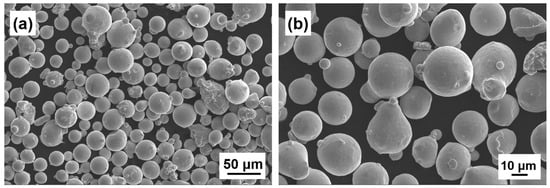
Figure 1.
Various magnifications of an IN718 powder image from a scanning electron microscope (SEM).

Table 1.
The IN718 powder’s chemical make-up.
Before printing, the stainless-steel substrate was preheated to 80 °C and protected with argon. The oxygen content was controlled below 100 ppm during printing. A stripe scanning strategy was used in this experiment, and the rotation angle of each layer was 67°. The volume energy density (VED) was calculated by , where P represents the laser power, v represents the scanning velocity, h represents the hatch spacing and t represents the layer thickness [12]. In the study, we conducted a series of orthogonal tests. The volume energy density ranged from 20.4 J/mm3 to 123.5 J/mm3. From the results of the study, the samples were mainly prone to unfused gas pores and keyhole defects, so we selected three typical process parameters for the experimental study and analyses. The main printing parameters in LPBF are shown in Table 2. The porosity of the three kinds of samples was measured by Image J software. A group of samples with the least porosity was selected for subsequent heat treatment. The specific heat treatment procedures and nomenclature associated with the specimens is listed in Table 3.

Table 2.
The parameters of the LPBF process.

Table 3.
The specific heat treatment in this work.
In order to observe the microstructure, the polished specimens were etched in a solution containing 5 g CuCl2, 7 g FeCl3, 100 mL HCl, 20 mL HNO3 and 100 mL H2O for 20 s. The optical microscope (OM, Keyence (China) Co., Ltd., Shanghai, China) and scanning electron microscope (SEM, Shanghai Lesser Spectrometer Analysis Technology Co., Ltd., Shanghai, China) fitted with energy-dispersive X-ray spectroscopy (EDS) were used to examine the microstructure of the samples. The sample was electro-polished in an electrolyte composed of a 70 vol% H3PO4 and 30 vol% H2O mixture. Through the use of electron backscatter diffraction (EBSD), the grain size and orientation of various samples were examined. To examine the precise microstructure and distribution of the precipitates, a transmission electron microscope (TEM, FEI USA, Inc., Hillsboro, OR, USA) using a Tecnai G2 F30 S-TWIN was run at 300 KV. Because the printed LPBF IN718 products (EOS Germany, Munich, Germany) were mainly used for engine components, which required a high load-bearing performance in the vertical XZ direction, this work focused on the vertical direction. After heat treatment, the samples’ grain and precipitate sizes were measured using Image J software. Tensile tests were performed at room temperature using a test machine, namely MTS-CMT4000 (MTS China Ltd., Shanghai, China), in order to investigate the impact of various heat treatments on mechanical properties. As shown in Figure 2, tensile test pieces were created in accordance with ASTM E139 standards.
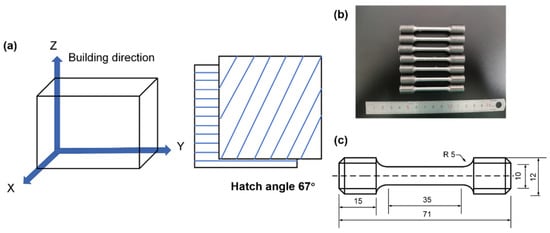
Figure 2.
Schematic diagrams of (a) the laser scanning strategy used in LPBF experiments, (b,c) the geometry of the tensile specimen (unit: mm).
3. Result and Discussion
3.1. Effect of Process Parameters on Porosity of LPBF IN718 Alloy
The OM morphologies of the samples with various volume energy densities are displayed in Figure 3. Different process parameters resulted in different pore sizes and distributions. The size of the pores first decreased with the increase in volume energy density before increasing. The lengths, widths and aspect ratios of the pores in the three process parameters of the samples were counted by Image J software. The statistical results are shown in Figure 4 to describe the evolution of pores. As can be seen in Figure 4, the S1 sample contained a sizable number of pores with an aspect ratio greater than 1. After the volume energy density increased, the morphologies of the pores changed greatly. Figure 4a,b illustrates that the most of the long pores were eliminated, and small pores took over as the dominant type. When the volume energy density extended to 84.4 J/mm3, the length and width of the pores increased, but its aspect ratio decreased as revealed in Figure 4c. In addition, as presented in Figure 4d, the porosity of the samples with three process parameters were 3.46%, 0.15% and 1.26%, respectively.
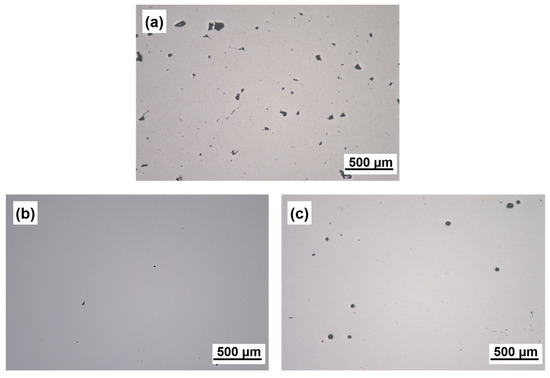
Figure 3.
OM morphologies of samples with different VED: (a) 43.8 J/mm3; (b) 60.0 J/mm3; (c) 84.4 J/mm3.
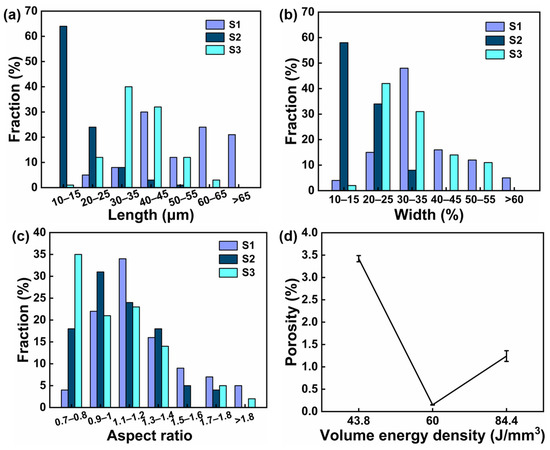
Figure 4.
The statistical results of pores with different VED: (a) length; (b) width; (c) aspect ratio; (d) porosity.
The pores in the LPBF IN718 alloy were mainly divided into three categories in the AM process: gas pores; lack-of-fusion pores; and keyhole pores [19]. In this study, pores with a length longer than 40 μm and a width greater than 30 μm were identified as lack-of-fusion pores. Because there wasn’t enough laser energy to melt the powder particles when the VED was lower, the majority of pores were lack-of-fusion pores, as shown in Figure 5a. When the volume energy density was increased to 60.0 J/mm3, the pores almost disappeared and the sample exhibited the best relative density, as shown in Figure 5b. A threshold of volume energy density existed during additive manufacturing, above which resulted in an increase in keyhole porosity [20]. In this experiment, the threshold value of the volume energy density was 60 J/mm3, and the porosity of the specimen increased when the volume energy density exceeded this value, as shown in Figure 5c. This was attributed to the high-power density that induced the oscillation of the molten pool and affected the overflow of bubbles during solidification. As the volume energy density increased, the pore type of the specimen was dominated by keyholes. In the IN718 alloy, pores easily become a source of failure cracks, leading to a reduction in fatigue life [21]. Therefore, in order to study the impact of various heat treatments on the evolution of the microstructure and mechanical properties, samples with the optimal volume energy density of 60 J/mm3 were chosen.

Figure 5.
The typical morphologies of the three main classifications of pores. (a) is lack-of-fusion pores, (b) is gas pores, (c) is keyhole pores.
3.2. Microstructure Characteristics of the LPBF IN718 Alloy
The X-Y microstructure of the as-built sample is depicted in Figure 6. Figure 6a shows a clearly visible striped-laser-scanning path. There were parallel distributions of the same layer’s contour lines, and there was a 67° rotation angle between the layers. According to Figure 6b, the dendrites had a dense distribution of the Laves phase. The mapping of the EBSD inverse-pole figure (IPF) in the X-Y plane is shown in Figure 6c to measure the as-built samples’ grain size. Columnar grains showed an equiaxed morphology in their cross-section. According to Figure 6d, the grains had an average size of 26.85 μm. A large number of dislocations and Laves phase morphologies were observed under TEM, and no other second phases were formed in the as-built samples, as shown in Figure 6e.
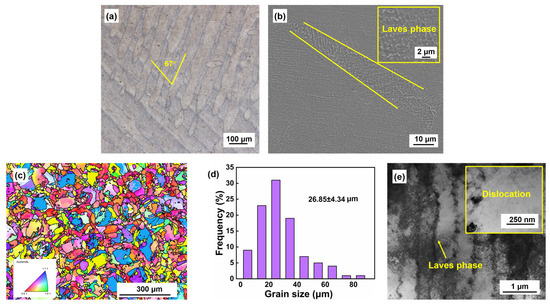
Figure 6.
The microstructure of AB samples in X-Y direction: (a) OM morphologies; (b) SEM image; (c) an EBSD inverse-pole figure (IPF) map; (d) grain size distributions; (e) TEM image.
The brittle Laves phase significantly decreased the alloy’s tensile strength and ductility. During plastic deformation, the Laves phase was a convenient source of cracks and a route for their spread, which caused the specimen to fracture too soon [7]. Moreover, the Laves phase precipitation used up a significant amount of the Nb element, which prevented enough Ni3Nb from precipitating during the aging stage [22]. Therefore, the IN718 alloy created by LPBF required heat treatment to homogenize the distribution of the alloy’s elements and to dissolve the destructive Laves phase because the Laves phase was harmful to the alloy’s mechanical properties [23].
Figure 7 depicts the microstructure of the specimen following single-solution heat treatment (SS). As seen in Figure 7a, the X-Y columnar patterns almost completely vanished. During the heat treatment of the solution at 980 °C, the Laves phase disintegrated and released a significant amount of the Nb element. The dissolved Laves phase could act as a nucleation site for the δ phase, which typically measured several micrometers and whose chemical composition was determined to be Ni3Nb in the IN718 alloy [24]. The δ phase showed both needle-like and short-rod-like shapes, as depicted in Figure 7b. The grains had an average size of 30.29 μm, as presented in Figure 7c,d.
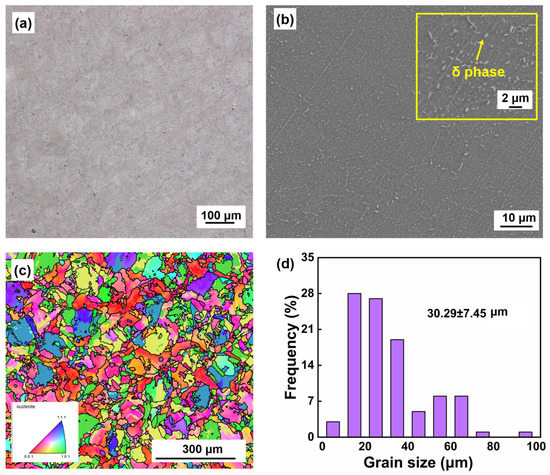
Figure 7.
The microstructure of SS samples in X-Y direction: (a) OM morphologies; (b) SEM image; (c) an EBSD inverse-pole figure (IPF) map; (d) grain size distributions.
The IN718 alloy required aging treatment in order to precipitate the strengthening phases of γ′/γ″ and fully utilize the material property [18]. The microstructure of the LPBF IN718 alloy following direct-aging heat treatment (DA) is depicted in Figure 8. The striped-laser-scanning path and layer rotation angle of 67° could still be observed after DA, as shown in Figure 8a. The Laves phase still existed inside the sample, as shown in Figure 8b, because the DA temperature was not high enough to dissolve it. The size of the Laves phase in the AB sample and the DA sample did not exhibit any significant difference. However, a large number of γ′/γ″-strengthening phases were precipitated in the DA sample. The average size of the grains was measured by Image J software, which was 28.36 μm, as presented in Figure 8c,d.

Figure 8.
The microstructure of DA samples in X-Y direction: (a) OM morphologies, (b) SEM image, (c) An EBSD inverse-pole figure (IPF) map, (d) Grain size distributions.
The high atomic diameter elements, such as Nb, Mo, and Ti, in the IN718 alloy had a low solubility limit in the matrix and were prone to segregation [25]. Due to the micro-segregations of these alloying elements, a large amount of Laves phases were formed in the IN718 alloy at the termination of the solidification process. Due to the low temperature of direct aging, the Laves phase was still presented in the samples that had undergone direct-aging heat treatment. However, a large amount of γ′/γ″-strengthened phases precipitated in the direct-aging heat-treated samples. In the single-solution heat-treated samples, the Laves phase dissolved and precipitated in the form of needles and short rods of the δ phase. The grain size of the samples did not change significantly before and after heat treatment.
3.3. Tensile Properties of LPBF IN718 Alloy
The AB, SS and DA samples were subjected to room temperature tensile tests in order to compare the effects of various heat treatments on the mechanical properties of the LPBF IN718 alloy. In Figure 9, the tensile results are displayed. The AB sample had the lowest strength with tensile and yield strengths of 980 and 620 MPa, respectively. The solution heat treatment dissolved the Laves phase, but the tensile strength of the SS sample was slightly increased because the strengthening phases did not precipitate in the matrix. In addition, the dissolution of the brittle Laves phase would contribute to the improvement of ductility. The DA sample had the highest strength with a tensile strength of 1458 MPa and a yield strength of 1271 MPa. This was due to rapid heating and cooling during the LPBF process, resulting in residual stress build-up and high dislocation density, which acted as strain-hardening [26]. On the other hand, the precipitation of the strengthening phases would lead to an increase in tensile strengths at the expense of ductility. The Laves phase was also associated with the lowest elongation in the DA sample at 16.9%.

Figure 9.
Tensile characteristics of the samples at room temperature.
As shown in Figure 10, the fracture morphologies of the samples were observed to clarify the effect of different heat treatments on the tensile properties. During tensile testing, microcracks usually start at the weakest point due to stress concentration, and then propagate to accelerate fracture [27]. The obvious dimples displayed ductile fracture characteristics. The dendrite morphology was maintained after the tensile test in the AB and DA samples. However, the SS sample lacked dendrite morphology.
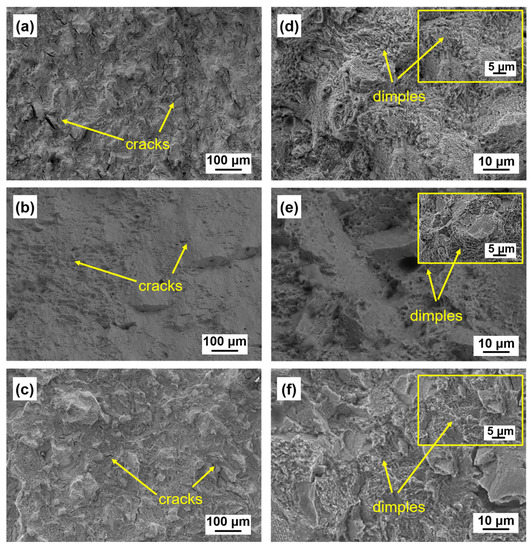
Figure 10.
Fracture surfaces of (a,d) AB sample, (b,e) SS-treated sample and (c,f) DA-treated sample.
Figure 11 shows the longitudinal sections of the fractures. In the AB sample, the Laves phase was a brittle phase, which could easily become a crack source and expand along it, as seen in Figure 11a. Therefore, the tensile properties of the AB sample had the lowest strength. The Laves phase disintegrated and precipitated the δ phase following solution heat treatment. The strength of the IN718 alloy was not significantly affected by the δ phase because it was incompatible with the matrix [28]. The δ phase, however, was fractured and migrated with the matrix in SS specimens, favoring the plastic deformation of the matrix by the precipitation of the δ phase at the grain boundaries. As shown in Figure 11b, the dissolution of the Laves phase led to a slight increase in the strength of the SS sample compared to the deposited state, while the fractured and migrated state with the matrix of the δ phase resulted in the highest elongation of the SS sample. In the DA samples, although the Laves phase still existed, the plastic deformation of the grains was not severe. The presence of the γ′/γ” phase would improve the tensile strength of the specimen, but due to the presence of the Laves phase, the location of its appearance was prone to defects and extension, depicted by a large number of white streaks of the Laves phase near the fracture (Figure 11c). Residual stress accumulated because of rapid heating and cooling during LPBF, which resulted in a high dislocation density and acted as strain-hardening. Due to the low temperature used during the aging heat treatment, the dislocation density remained relatively high [18]. This could account for the DA sample’s higher strength. However, from the results of the fracture analysis, there was still a large amount of Laves phases, so the subsequent work focused on how to further increase the proportion of the γ′/γ”-strengthened phase and reduce the Laves phase content.

Figure 11.
The SEM photographs of the longitudinal sections of the fractures: (a) AB; (b) SS; (c) DA.
4. Conclusions
The effect of process parameters on the porosity and the effect of heat treatment on the microstructure evolution and tensile properties of the LPBF IN718 alloy were investigated. The present work investigated the microstructure evolution in heat treatment and the influence of the second phases on the tensile properties. The following conclusions could be drawn:
1. The lack-of-fusion pores, gas pores and keyhole pores are the types of pores found in the samples for the various process parameters. When the volume energy density reached 60 J/mm3, the lowest porosity in the samples was noted.
2. The Laves phase that distributed densely among the dendrites could be observed in the AB sample. After solution heat treatment, the Laves phase dissolved and the δ phase precipitated, while the γ′/γ” phases were precipitated under aging heat treatment. The grain size of the samples did not change significantly before and after the heat treatment.
3. The tensile strength of the SS sample was slightly increased because the strengthening phases did not precipitate in the matrix. Due to strain-hardening, the DA sample had the highest strength. The Laves phase played a role as the crack initiator, resulting in the AB sample having the lowest strength. The strength of the heat-treated specimens was improved due to the dissolution of the Laves phase and the precipitation of the γ′/γ”-strengthened phase.
4. The sample of 60.0 J/mm3 was chosen for heat treatment. In single-solution heat treatment, the needle-like δ phase was distributed along the grain boundaries, which increased the tensile strength and had the highest elongation of 34.5 %. In the direct-aging heat treatment, although the Laves phase was still present, the precipitation of the γ′/γ”-strengthened phase resulted in the highest tensile strength and yield strength of the sample, 1458 and 1271 MPa, respectively.
Author Contributions
H.L.: Funding acquisition, Writing—review and editing, Supervision. W.C.: Conceptualization, Investigation, Data curation, Writing—original draft. Y.S.: Conceptualization, Writing—review and editing. R.M.: Investigation, Supervision. Y.W.: Supervision, Conceptualization. J.B.: Supervision. L.X.: Investigation, Supervision. X.S.: Supervision, Investigation, Project administration. C.T.: Writing—review and editing, Project administration, Conceptualization, Funding acquisition. All authors have read and agreed to the published version of the manuscript.
Funding
The work was supported by the Natural Science Foundation for Excellent Young Scholars of Shangdong Province (ZR2021YQ30) and Zhejiang Key Project of Research and Development Plan (2021C01085).
Institutional Review Board Statement
Not applicable.
Informed Consent Statement
Not applicable.
Data Availability Statement
Not applicable.
Conflicts of Interest
The authors declare no conflict of interest.
References
- Luo, S.; Huang, W.; Yang, H.; Yang, J.; Wang, Z.; Zeng, X. Microstructural evolution and corrosion behaviors of Inconel 718 alloy produced by selective laser melting following different heat treatments. Addit. Manuf. 2019, 30, 100875. [Google Scholar] [CrossRef]
- Mantri, S.A.; Dasari, S.; Sharma, A.; Alam, T.; Pantawane, M.V.; Pole, M.; Sharma, S.; Dahotre, N.B.; Banerjee, R.; Banerjee, S. Effect of micro-segregation of alloying elements on the precipitation behaviour in laser surface engineered Alloy 718. Acta Mater. 2021, 210, 116844. [Google Scholar] [CrossRef]
- Harrison, N.J.; Todd, I.; Mumtaz, K. Reduction of micro-cracking in nickel superalloys processed by Selective Laser Melting: A fundamental alloy design approach. Acta Mater. 2015, 94, 59–68. [Google Scholar] [CrossRef]
- Balbaa, M.; Mekhiel, S.; Elbestawi, M.; McIsaac, J. On selective laser melting of Inconel 718: Densification, surface roughness, and residual stresses. Mater. Des. 2020, 193, 108818. [Google Scholar] [CrossRef]
- Kang, Y.-J.; Yang, S.; Kim, Y.-K.; AlMangour, B.; Lee, K.-A. Effect of post-treatment on the microstructure and high-temperature oxidation behaviour of additively manufactured inconel 718 alloy. Corros. Sci. 2019, 158, 108082. [Google Scholar] [CrossRef]
- Zhang, D.; Zhang, P.; Liu, Z.; Feng, Z.; Wang, C.; Guo, Y. Thermofluid field of molten pool and its effects during selective laser melting (SLM) of Inconel 718 alloy. Addit. Manuf. 2018, 21, 567–578. [Google Scholar] [CrossRef]
- Zhang, S.; Wang, L.; Lin, X.; Yang, H.; Huang, W. The formation and dissolution mechanisms of Laves phase in Inconel 718 fabricated by selective laser melting compared to directed energy deposition and cast. Compos. Part B Eng. 2022, 239, 109994. [Google Scholar] [CrossRef]
- McLouth, T.D.; Witkin, D.B.; Bean, G.E.; Sitzman, S.D.; Adams, P.M.; Lohser, J.R.; Yang, J.-M.; Zaldivar, R.J. Variations in ambient and elevated temperature mechanical behavior of IN718 manufactured by selective laser melting via process parameter control. Mater. Sci. Eng. A 2020, 780, 139184. [Google Scholar] [CrossRef]
- Amato, K.N.; Gaytan, S.M.; Murr, L.E.; Martinez, E.; Shindo, P.; Hernandez, J.; Collins, S.; Medina, F. Microstructures and mechanical behavior of Inconel 718 fabricated by selective laser melting. Acta Mater. 2012, 60, 2229–2239. [Google Scholar] [CrossRef]
- Sabelkin, V.P.; Cobb, G.R.; Shelton, T.E.; Hartsfield, M.N.; Newell, D.J.; O’Hara, R.P.; Kemnitz, R.A. Mitigation of anisotropic fatigue in nickel alloy 718 manufactured via selective laser melting. Mater. Des. 2019, 182, 108095. [Google Scholar] [CrossRef]
- Liu, S.; Li, H.; Qin, C.; Zong, R.; Fang, X. The effect of energy density on texture and mechanical anisotropy in selective laser melted Inconel 718. Mater. Des. 2020, 191, 108642. [Google Scholar] [CrossRef]
- Watring, D.S.; Benzing, J.T.; Hrabe, N.; Spear, A.D. Effects of laser-energy density and build orientation on the structure–property relationships in as-built Inconel 718 manufactured by laser powder bed fusion. Addit. Manuf. 2020, 36, 101425. [Google Scholar] [CrossRef]
- Yang, H.; Meng, L.; Luo, S.; Wang, Z. Microstructural evolution and mechanical performances of selective laser melting Inconel 718 from low to high laser power. J. Alloy. Compd. 2020, 828, 154473. [Google Scholar] [CrossRef]
- Nope, G.d.L.; Perez-Andrade, L.; Corona-Castuera, J.; Espinosa-Arbelaez, D.; Muñoz-Saldaña, J.; Alvarado-Orozco, J. Study of volumetric energy density limitations on the IN718 mesostructure and microstructure in laser powder bed fusion process. J. Manuf. Process. 2021, 64, 1261–1272. [Google Scholar] [CrossRef]
- Zhang, D.; Niu, W.; Cao, X.; Liu, Z. Effect of standard heat treatment on the microstructure and mechanical properties of selective laser melting manufactured Inconel 718 superalloy. Mater. Sci. Eng. A 2015, 644, 32–40. [Google Scholar] [CrossRef]
- Sharma, S.; Palaniappan, K.; Mishra, V.D.; Vedantam, S.; Murthy, H.; Rao, B.C. Mechanical Characterization of Near-Isotropic Inconel 718 Fabricated by Laser Powder-Bed Fusion. Metall. Mater. Trans. A 2023, 54, 270–285. [Google Scholar] [CrossRef]
- Gruber, K.; Dziedzic, R.; Kuźnicka, B.; Madejski, B.; Malicki, M. Impact of high temperature stress relieving on final properties of Inconel 718 processed by laser powder bed fusion. Mater. Sci. Eng. A 2021, 813, 141111. [Google Scholar] [CrossRef]
- Huang, W.; Yang, J.; Yang, H.; Jing, G.; Wang, Z.; Zeng, X. Heat treatment of Inconel 718 produced by selective laser melting: Microstructure and mechanical properties. Mater. Sci. Eng. A 2019, 750, 98–107. [Google Scholar] [CrossRef]
- Zheng, M.; Wei, L.; Chen, J.; Zhang, Q.; Zhang, G.; Lin, X.; Huang, W. On the role of energy input in the surface morphology and microstructure during selective laser melting of Inconel 718 alloy. J. Mater. Res. Technol. 2021, 11, 392–403. [Google Scholar] [CrossRef]
- King, W.E.; Barth, H.D.; Castillo, V.M.; Gallegos, G.F.; Gibbs, J.W.; Hahn, D.E.; Kamath, C.; Rubenchik, A.M. Observation of keyhole-mode laser melting in laser powder-bed fusion additive manufacturing. J. Mater. Process. Technol. 2014, 214, 2915–2925. [Google Scholar] [CrossRef]
- Cheng, W.; Liu, H.; Tan, J.; Yu, Z.; Shu, Q. Microstructure Analysis and Fatigue Behavior of Laser Beam Welding 2060-T8/2099-T83 Aluminum–Lithium Alloys. Coatings 2021, 11, 693. [Google Scholar] [CrossRef]
- Sui, S.; Tan, H.; Chen, J.; Zhong, C.; Li, Z.; Fan, W.; Gasser, A.; Huang, W. The influence of Laves phases on the room temperature tensile properties of Inconel 718 fabricated by powder feeding laser additive manufacturing. Acta Mater. 2019, 164, 413–427. [Google Scholar] [CrossRef]
- Zhou, L.; Mehta, A.; McWilliams, B.; Cho, K.; Sohn, Y. Microstructure, precipitates and mechanical properties of powder bed fused inconel 718 before and after heat treatment. J. Mater. Sci. Technol. 2019, 35, 1153–1164. [Google Scholar] [CrossRef]
- Zhang, S.; Wang, L.; Lin, X.; Yang, H.; Li, M.; Lei, M.; Huang, W. Precipitation behavior of δ phase and its effect on stress rupture properties of selective laser-melted Inconel 718 superalloy. Compos. Part B Eng. 2021, 224, 109202. [Google Scholar] [CrossRef]
- Kumara, C.; Balachandramurthi, A.R.; Goel, S.; Hanning, F.; Moverare, J. Toward a better understanding of phase transformations in additive manufacturing of Alloy 718. Materialia 2020, 13, 100862. [Google Scholar] [CrossRef]
- Zhang, S.; Lin, X.; Wang, L.; Yu, X.; Hu, Y.; Yang, H.; Lei, L.; Huang, W. Strengthening mechanisms in selective laser-melted Inconel718 superalloy. Mater. Sci. Eng. A 2021, 812, 141145. [Google Scholar] [CrossRef]
- Firoz, R.; Basantia, S.; Khutia, N.; Bar, H.; Sivaprasad, S.; Murthy, G. Effect of microstructural constituents on mechanical properties and fracture toughness of Inconel 718 with anomalous deformation behavior at 650 °C. J. Alloy. Compd. 2020, 845, 156276. [Google Scholar] [CrossRef]
- Le, W.; Chen, Z.; Yan, K.; Naseem, S.; Zhao, Y.; Zhang, H.; Zhang, Z. Early evolution of δ phase and coarse γ´´ phase in Inconel 718 alloy with high temperature ageing. Mater. Charact. 2021, 180, 111403. [Google Scholar] [CrossRef]
Disclaimer/Publisher’s Note: The statements, opinions and data contained in all publications are solely those of the individual author(s) and contributor(s) and not of MDPI and/or the editor(s). MDPI and/or the editor(s) disclaim responsibility for any injury to people or property resulting from any ideas, methods, instructions or products referred to in the content. |
© 2023 by the authors. Licensee MDPI, Basel, Switzerland. This article is an open access article distributed under the terms and conditions of the Creative Commons Attribution (CC BY) license (https://creativecommons.org/licenses/by/4.0/).